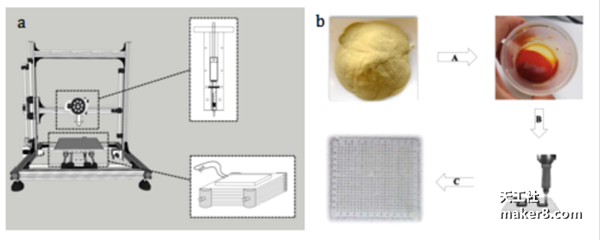University of Parma FDM 3D printing chitosan, low cost manufacturing tissue culture scaffold
In order to culture transplanted tissue or even intact organs with cells taken from the patient's own, one needs a hydrogel-based device to support cell growth. Faced with this growing demand, a team at the University of Parma in Italy suggested using a custom FDM 3D printer to make hydrogel equipment. The study has been published online in the journal Biomedical Materials.
In a medical study at the University of Parma, the researchers chose to use a custom FDM 3D printing machine, hoping to prove FDM has sufficient accuracy and repeatability to low-cost manufacturing custom shapes. They replaced the conventional nozzle on the printer with a syringe pump. The print bed was also replaced with a cooling system and a Peltier plate to maintain an ambient temperature for gel printing.

Researchers use chitosan to make gels, a compound that appears in the shells of shrimp, crabs, and other crustaceans. As a hydrogel, chitosan also shows the potential to make self-healing objects that one day might use to make a more powerful computer screen.
To optimize the chitosan hydrogel formulation, the researchers added raffinose from hard vegetables (such as cabbage, broccoli) as a stabilizer, which allows chitosan to be solid-modified to avoid 3D printing. Chitosan in a diluted state. This mixture is the key to the success of the gel.

After making the gel, the researchers used it to print the cell scaffold in 3D and compared the scaffold to the same device that was produced in a conventional manner. They also added live cells to both stents. After 28 days of culture, the final results indicated that the cells in the 3D printed chitosan exhibited "an enhanced biocompatibility derived from production techniques." This proves that FDM is a suitable choice for hydrogel manufacturing.
- Remarkable Coloring Effect :The Creamy Formula Has A Satiny Smooth, Weightless Texture - Weightless All Day Wear With No Creasing.Sheer, soft focus color blends beautifully to create a natural makeup.
- HELPS BLUR IMPERFECTIONS: Enriched with moisturizing emollients for a smooth glide, each innovative color stick is also blended with ultra-fine pigments for bold, rich color and soft-focus powder, which help to blur imperfections.
- HOW TO WEAR: Apply to eyes, lips, and cheeks, and blend with a brush or fingertips. Use alone or as a base for powder products for even longer-lasting color.
- FREE FROM: All TINTS FESTS products are 100% free from phthalates, parabens, nonylphenol, ethoxylates, triclosan, triclocarban, and hydroquinone.
- BEAUTY FOR ALL: TINTS FESTS Cosmetics provides professional-quality products at get-real prices, because we believe beauty should be accessible to every eye, lip, and face.
cream blush stick , best blush stick , creamy blush stick , best cream blush stick , cheek blush stick
Guangzhou Vast Internation Trade Co.,Ltd , https://www.tintsfeast.com